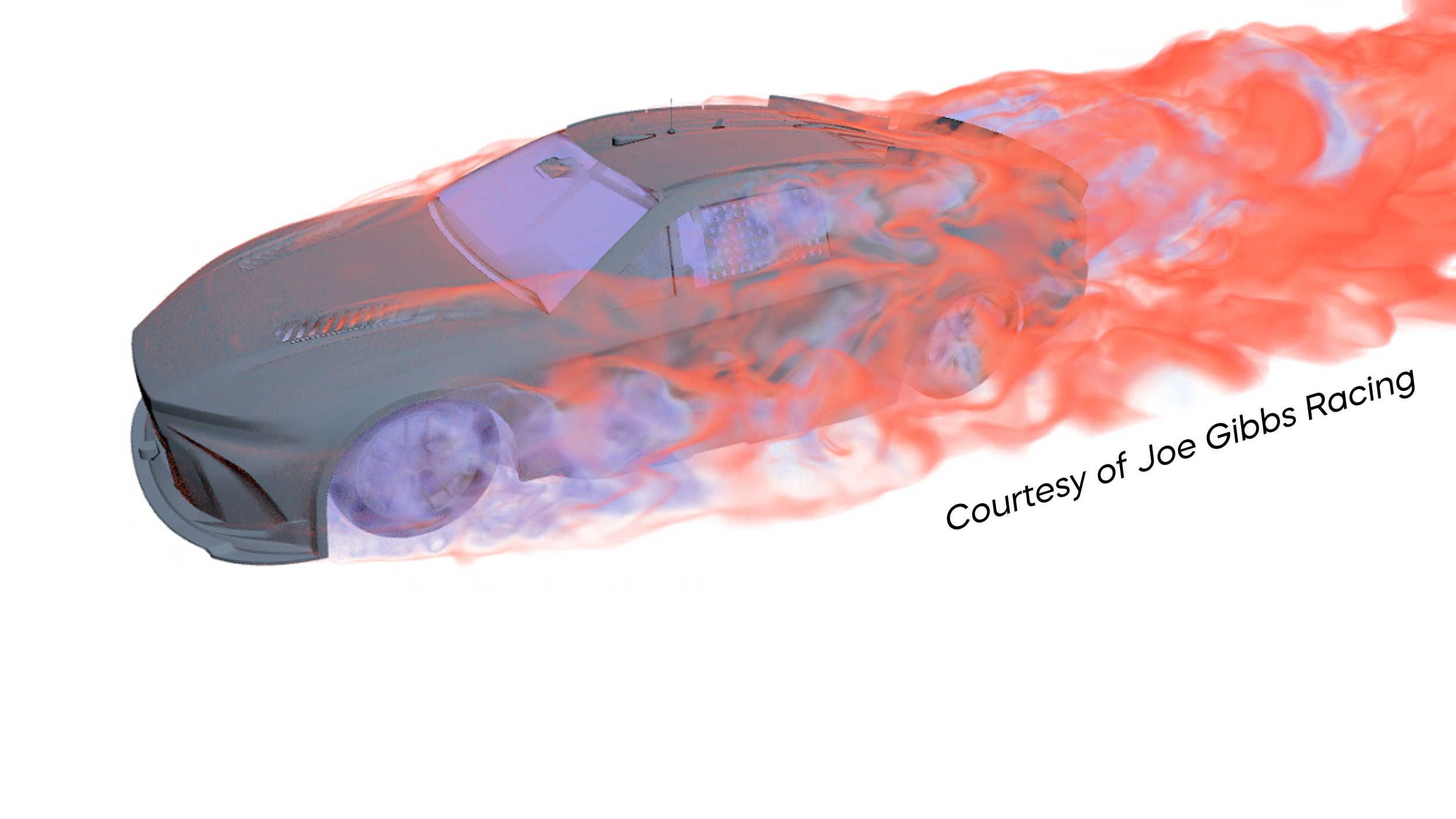CFD for HPC
Computational Fluid Dynamics Analysis on High Performance Computing
Enhance Your Computational Fluid Dynamics Analysis With Our High-Speed, Compute Resources Created by Engineers Like You
Our intuitive web-based interface allows users to run CFD workflows end-to-end—mesh, model, submit jobs, and post-process—without ever touching the command line. Whether you're using commercial tools like Ansys Fluent software or government codes coupled with ANSA, Pointwise, or ParaView, Corvid HPC streamlines the entire process.

What is the value of HPC for CFD Simulation?
Corvid HPC offers large numbers of CPUs and GPUs with high memory bandwidth, which significantly reduces the time to solve large and complex problems among fluid simulation. This also allows for higher fidelity modelling with high-resolution meshes, detailed geometry, and multi-physics models. By offloading simulations to Corvid HPC, local workstations remain free for other tasks like preprocessing, postprocessing, or different projects.
Applications of Computational Fluid Dynamics
Corvid HPC supports aerodynamic design and fluid simulation for:
Supported CFD Tools
Corvid HPC provides scalable, high-performance cloud infrastructure for Ansys Fluent software—accelerate your CFD simulations and reduce turnaround time. Ansys Fluent software can be run multiple ways on Corvid HPC:
Interactive Fluent GUI with client/server connection between HPC Desktop and HPC compute resources for a window-like experience
Batch submission via Corvid HPC’s own GUI based submission tools
Batch submission via CLI with text based journals and scripts
Bring custom workflows which may include Python scripting with PyAnsys
Corvid HPC delivers high-performance cloud resources for Simcenter™ STAR-CCM+™ software—with improved speed and resource efficiency—delivering quicker results and maximizing engineering productivity. Users can take advantage of multiple ways to run on HPC:
Interactive STAR-CCM+ GUI desktop-like experience between the HPC environment and the local user interface
Batch submission through Corvid HPC’s built-in GUI-based tools for streamlined job configuration and execution
Command-line batch submission using STAR-CCM+ shell scripts for full automation and repeatability
Support for custom workflows including automation via STAR-CCM+’s Java macros, Python scripting, or integration with external tools and pipelines
RavenCFD
Corvid HPC enables automotive and aerospace engineers to run large-scale RavenCFD simulations for external aerodynamics and aerothermal analysis. Whether you're predicting drag, surface heating, or shock interaction, RavenCFD delivers robust, high-fidelity solutions across the full Mach spectrum with industry-leading parallel scalability.
Automated meshing toolkit can be delivered for various aerospace vehicle geometries leveraging an ANSA license
Interactive submission can be completed through our own tool CV Database to automate submission of several to 1000’s of cases
Batch submission via CLI
Corvid HPC empowers turbomachinery, pump, and rotating equipment engineers to run high-fidelity CFX software simulations faster and at greater scale. Whether you're modeling blade row interactions, cavitation, or transient performance, our HPC platform reduces turnaround time and boosts simulation throughput.
CFX Launcher can submit to the cluster using the native Ansys GUI
Batch submission via Corvid HPC’s own GUI based submission tools
Run design points concurrently using parametric run capability enabled by Ansys HPC licensing
Converge CFD
Corvid HPC enables engineers using Converge CFD to simulate complex internal combustion, spray, and reacting flow problems with higher fidelity and reduced turnaround time. Our scalable infrastructure supports parallel meshing and combustion modeling at production scale.
GUI or CLI-driven job submission via Corvid HPC’s interface
Batch submission of large DOE studies or transient runs
Ideal for parametric sweeps using automated Converge workflows
CharLES
Corvid HPC supports high-fidelity LES simulations using CharLES, enabling users to resolve complex turbulent flow structures in aerospace and propulsion applications. Our infrastructure is tuned for scalability across many cores or GPUs, ideal for long-duration, unsteady simulations.
CLI-based batch submission for CharLES solver runs
Supports large-scale LES and DNS simulations in research or design environments
Pre and post processing supported via Corvid HPC desktop environment
Corvid HPC has optimized FUN3D builds for CPU & GPUs, enabling scalable, efficient simulation of high-Mach compressible flows for reentry, hypersonics, and aerodynamic databasing. Trusted by government and industry, FUN3D users benefit from quick job turnaround and campaign-level throughput.
Batch or scripted job submission for parametric sweeps
Supports parallel adjoint, overset, and turbulence model workflows
Ideal for large-scale aerodynamic databases and design studies
Corvid HPC accelerates combustion and propulsion modeling with VULCAN, NASA’s structured reactive flow solver. Perfect for simulating high-speed reacting flows in scramjets and chemical propulsion systems.
CLI-based batch job submission with support for custom input structures
Tuned infrastructure for multiphysics coupling with chemistry and turbulence models
Supports grid convergence studies, sensitivity analysis, and parameter sweeps
Corvid HPC supports OVERFLOW, NASA’s overset structured CFD solver, ideal for modeling full vehicle aerodynamics, rotorcraft, and moving-body simulations. Our HPC environment handles large meshes and transient workflows with ease.
Batch and CLI-based submission of complex overset simulations
Optimized for Chimera grid handling and large geometry setups
Supports rotorcraft, aeroelastic, and vehicle separation studies
LOCI/CHEM (Mississippi State University)
Corvid HPC supports high-speed, reacting flow simulations with LOCI/CHEM—widely used for scramjet and combustion modeling. Designed for tightly coupled physics and reacting gas models, LOCI/CHEM thrives in Corvid’s scalable, parallel environment.
Batch job submission and script-driven workflows
Supports full-physics models including real gas effects and detailed chemistry
Ideal for propulsion, hypersonics, and high-enthalpy flow simulations
OpenFOAM
Accelerate CFD innovation with OpenFOAM on HPC. Leverage scalable, high-performance infrastructure to run simulations faster and more efficiently on OpenFOAM—reducing turnaround time and increasing engineering throughput. Corvid HPC makes it easy for teams to run OpenFOAM through workflows that match their needs:
Interactive remote desktop access to a full Linux environment, ideal for pre/post-processing, visualization, and hands-on simulation control
Easy batch submission through intuitive HPC GUI tools—simplify repeatable simulation runs without needing complex scripting
Advanced command-line workflows for engineers who prefer automation, custom scripts, or parameter sweeps
Support for customized processes, including scripted automation and high-throughput studies using your existing toolchain
Empower your engineers to spend less time waiting and more time innovating.
Barracuda Virtual Reactor by CPFD Software
Corvid HPC delivers powerful GPU-native infrastructure purpose-built for Barracuda Virtual Reactor, enabling engineers to simulate fluidized beds, particle-laden flows, and gas-solid reactors with speed and precision. Run large, transient multiphase simulations in hours—not days—without compromising accuracy.
Launch simulations directly from the Barracuda GUI—no command line needed
Leverage NVIDIA GPUs to dramatically accelerate solve times
Ideal for energy, chemical processing, and advanced materials applications
COMSOL Multiphysics
Corvid HPC enables engineers and scientists to easily access COMSOL CFD. COMSOL is well suited for simulating complex physical phenomena like those encountered in microfluidics and multiphysics including heat transfer, chemical reactions, structural mechanics, and electromagnetics—all within a single user-friendly platform.
COMSOL is available using the interactive GUI or CLI batch submission
Leverage NVIDIA GPUs to dramatically accelerate simulations



